Have you recently become interested in country guitar playing? It seems like the whole world has suddenly decided to get into country, and for guitarists, that’s no bad thing! Country is about as ‘guitary’ a genre as you can get, with many of the world’s top players living and working in either the Nashville scene or as an alternative to that.
If you are newly invested in the country vibe, you might want to be looking at getting some gear that’ll countrify your sound, right? That’s what today’s blog is all about. There are definitely certain guitars, pedals and amps that will be more suited to country style than others, and my aim is to guide you to them. I’ll often talk generally, but I’ll mention specific pieces of gear when it’s appropriate. You can pick up on what sounds right for you, and leave what doesn’t.
Whether you want a Nashville guitar sound or something from the other side of the tracks, I’ll help you get there today.
Contents
Best Electric Guitars for Country Music
Choosing a Telecaster for Country
Lap Steels, Pedal Steels & B-Benders for Guitar
Best Guitar Amplifiers for Country Guitar
Effects Pedals for Country Guitar
Best Electric Guitars for Country Music
- Overwhelmingly, a Fender Telecaster is the number once choice
- Low-to-mid output is better than super-hot
- It really is all in the hands
- Gretsch hollow bodies are a good alternative
Let me get to the chase. You’re going to have to have a really, really strong reason not to go for a Fender Telecaster here. If this blog is about finding the correct tools for the job, then this is the bullseye guitar for country playing.
Why? Simply put, the majority of country artists and Nashville session players have used Telecasters over the decades. The Tele has a twang that no other guitar can grant you, and it’s overwhelmingly the sound for country leads, chicken pickin’ and all the rest of that good stuff. Teles have a bite that helps rhythms sound percussive, and have enough output for leads and slide playing to convince. They sit well in a mix and they don’t dominate, unless you want them to.
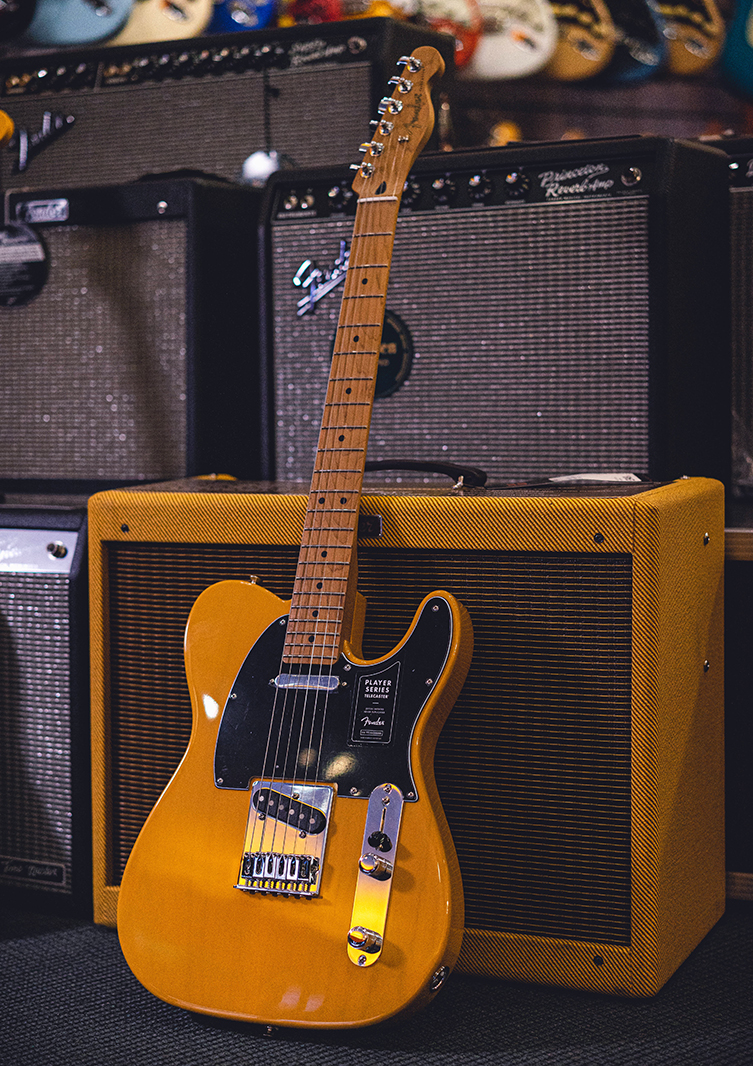
You could go for an Esquire of course, since that is essentially a Tele with slightly different tone options, but I still reckon you’re better off with a more regular two-pickup Telecaster. Why not have the proper choice of tones? Teles sound tougher than Strats (too soft for country rhythms), not as tough sounding as Les Pauls (too big and round sounding), but most importantly, they give you exactly the right sound and look for playing country.
Those people who say ‘you can play any style on any guitar’ are just attention seekers who don’t know what they want. By all means be civil to them, and nod your head politely whilst choosing a good Telecaster.
Choosing a Telecaster for Country
But which Telecaster to go for? It’ll sound flippant to say, but any and all proper Fender ones will give you the special Tele country tone in greater or lesser degrees. Go with your budget, try to buy one with alnico pickups, and if you can, brass bridge saddles. Here’s a short rundown of a few I’d look at if I were you…
Fender Player II Telecaster
The Fender Player II Telecaster is the affordable workhorse with all the main features you need. I personally think these sound significantly nicer than the Fender Standard Series Tele, but there is about a £300 difference in price, so maybe a Standard Tele with a pickup change will work well for you. The Player II Tele in Butterscotch actually has a chambered ash body too, so there’s extra resonance and some weight relief happening here, too! Star buy!
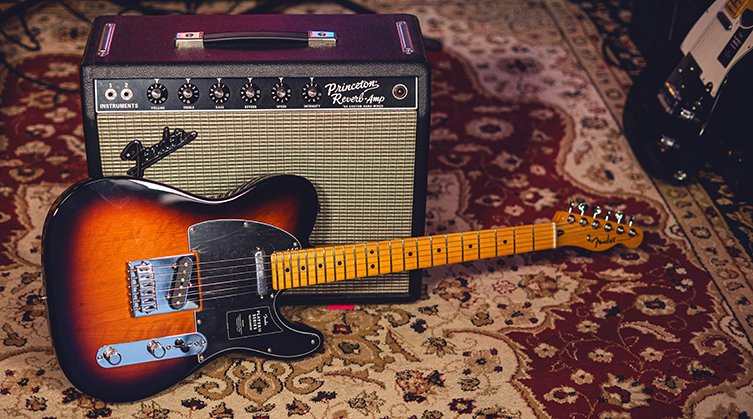
Fender Jason Isbell Telecaster
Why not check out the signature guitar of an actual country star? The Fender Jason Isbell Telecaster has a lovely neck, gorgeous body binding (it makes any guitar instantly cooler in my book), a Roadworn finish (it means lightly relic’d) and a very ‘Strat’ sounding neck pickup which might be exactly what you need in a ‘best of both worlds’ way.
You don’t even have to be an Isbell fan to enjoy this: the branding is minimal, with only a logo on the neckplate to identify it as an artist model.
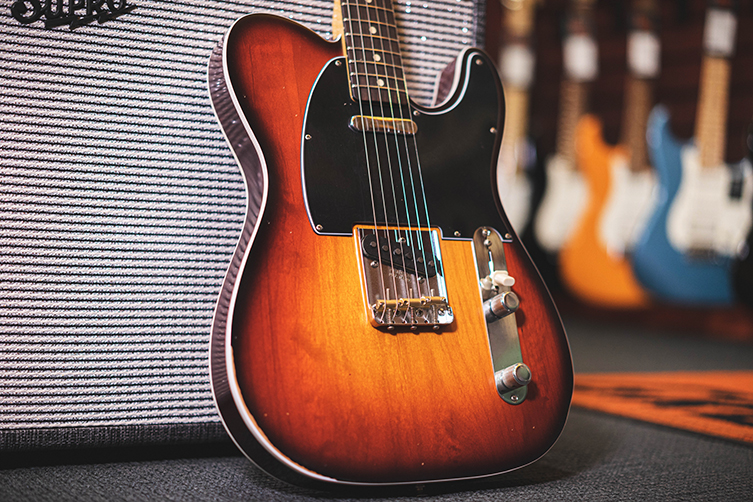
Fender American Ultra Luxe Vintage 50s Telecaster
The title is a bit of a mouthful, but the Fender American Ultra Luxe Vintage 50s Telecaster is a great shout for the country player. Designed to offer a mix of vintage appeal with contemporary playability, the 50s Tele model is hard to beat and harder to put down once you start playing!
I love the heirloom finish (slightly cracked nitrocellulose, like a vintage guitar) and the brass saddles, but also the flatter fingerboard and chunkier stainless steel frets. Country music can be a very demanding genre for a lead guitarist, and to have something that looks and sounds like a vintage Tele but plays almost like a modern Jackson is a great thing for all guitarists. What a world we live in!
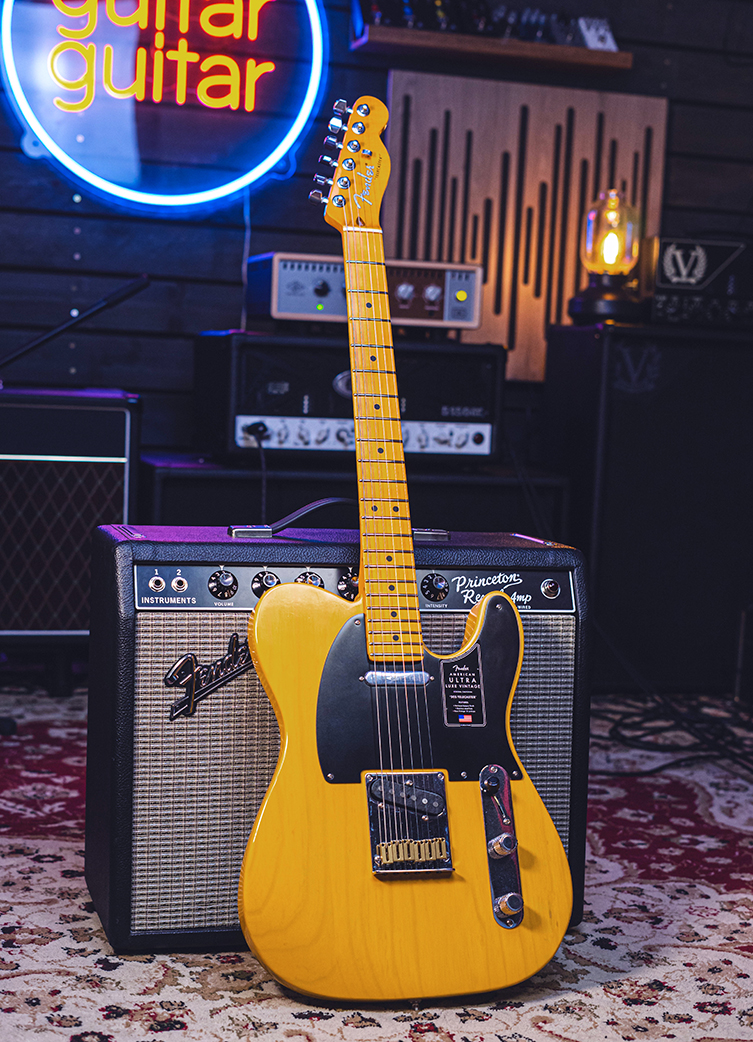
That’s a few Telecasters to get you into the swing of what’s out there. If you are playing country leads, or a mixture of leads and rhythms, then a Tele is the way to go. If, however, you are in a two-guitar band, and the other person already has a Tele, then you might want something else. Here is the ‘other’ country guitar…
Gretsch Hollowbody
Gretsch guitars are beautiful and idiosyncratic. Big and showy, they have always been the choice of frontpeople, and their inimitable sound lends itself to percussive country rhythms. Gretsch make solid body guitars, semi hollow and hollow bodies. For authentic country vibes, go fully hollow! If money allows it, the Gretsch Professional Collection is the way to go, but if funds are tight, you can find excellent Gretsch guitars in the Electromatic range and the most affordable Streamliner Collection.
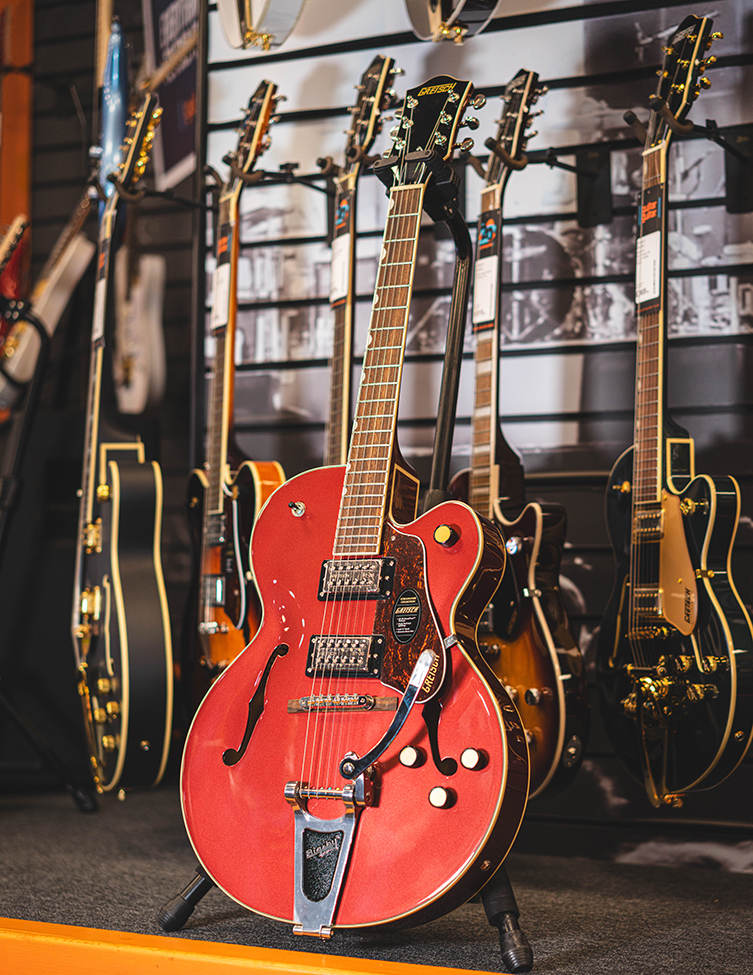
Gretsch is what you hear Chet Atkins playing on Elvis records, but the brand has also been used by other country greats such as Chris Stapleton, Albert Lee, Vince Gill and more. Tele first, Gretsch as a great alternative.
Lap Steels, Pedal Steels & B-Benders for Guitar
- Specialised instruments for specific sounds
- Lap Steels are a whole ‘nother thing entirely
- Mod an existing guitar for cheap slide fun
- B-Benders are a real commitment
As you’ll know, lap and pedal steels factor largely in country music. They give any tune an instant authenticity as ‘country’, and so it’s important to at least address that.
Pedal steel is a flat-out different instrument. It’s not really a guitar, and it’s not something that most guitarists ever even see offstage, far less play. If you want to go down that route, then you need to seek a pedal steel expert, learn the secret handshake, and prepare for years of practice. In short, pedal steel falls outside the scope of what I’d call ‘country guitar playing’, so I won’t say anything more about it on this blog. It’s a phenomenal sound though, and well worth pursuing if that’s your heart’s desire!
Now, lap steel, on the other hand, that’s much more reachable for the general guitarist. Lap steels are specific instruments that sit on your lap and get played with either a slide or a tone bar, which is literally a smooth bar of metal. Lap steels have 6 strings like a guitar (there are variations) and you tune them to open guitar tunings such as Open G and so on.
Lap steels can be as expensive as any other guitar, but I feel that the emerging player can get great results from a relatively inexpensive one. Check out this handsome Gretsch G5700 with lovely retro styling and a chrome bridge for your right hand to rest on. It’s a perfect mix of quality and affordability, and it sounds lovely!
You can, of course, simply adjust a regular guitar for slide. Heavy strings, a high action and an open tuning will get you there, for the most part. A new, higher nut can be installed for permanent alterations, and for all lap steel needs, your existing amps and pedals will do the job. More on those in a sec!
Lastly, B-Benders. B-Benders are a technology designed to simulate the sound of a pedal steel using a regular guitar. Versions exist that sit atop your guitar bridge (manipulated by your right hand) or are routed into the guitar body itself, like the Parsons B-Bender. This style is operated by physically pulling the guitar downwards when it’s round your neck on a strap. The strap button is the lever, and the lever goes through the body to the bridge and moves the B string only. It's a lot of convoluted work just to get a cheeky little bend! But if that’s what you want, those are some options.
Best Guitar Amplifiers for Country Guitar
- Tube combos are the way to go
- Fender are the obvious choice, again
- Clean, with good headroom
These days, we live in a world where amplifiers are optional things for electric guitarists. Digital modeling is a legitimate and feasible choice for us all, so instead of going through a range of possible country-friendly modellers, just take the info on amps today and apply that (and the effects advice, for that matter) to your chosen modeller.
Okay, back to amps! Without real-deal amps, there would be nothing to model in the first place! So anyway, when it comes to country tone, one brand name does figure large in proceedings. It’s Fender again, and no, this blog was not paid for by them! They are simply the company who put out the right gear for this sound back in the day, and people have continued to use them since.
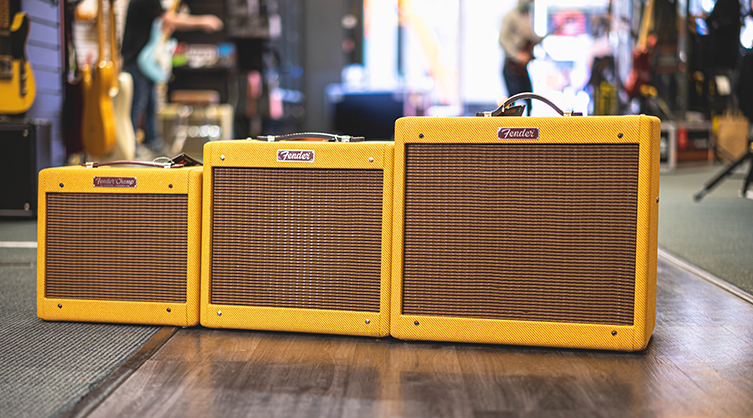
Fender amps are not all built alike, and so I would direct you towards their all-valve/tube models over something like a Mustang. I feel that a certain nod to tradition befits any budding country guitarist, and so a valve Fender combo is the way to go for that clean, clear tube tone.
Which model, though? Well, that does depend on your requirements. Most of the current Fender offerings that come dressed in black or tweed coloured tolex will serve up that famous glassy Fender clean tone, so it’s more a matter of size and volume. As a general starting point, there’s a reason why so many players choose the Fender Blues Junior IV. It’s small enough to carry easily, it has 15 watts of valve power and it delivers that proper Fender tone. It won’t do heavy metal for you, but then that’s hardly what we’re looking for today, are we?

There are lots of amps that will suit country players, so my general advice is this. Speaking very broadly, the vast majority of guitar amps on the market are based one way or another on either Fender, Vox or Marshall originals. For country guitar sounds, go for the ones that are based on Fender designs, if not Fender themselves. Bigger amps will always sound nice when clean; smaller ones may start overdriving when pushed to their limit. This is a genre where you generally don’t want that, so if your band is loud - or if you are playing larger places - then maybe go a size up from the Blues Junior to a Blues Deluxe, or even consider a Fender Twin with the caveat that this particular amp is TERRIFYINGLY loud. You will not be using a Fender Twin in your home, ok?
Effects Pedals for Country Guitar
- Simple and effective is key
- Compression can really level-up your sound
- Don’t go overboard with ambience, but do use it
Despite a generally ‘straight up’ approach to guitar tone, there’s still a lot of benefit in having a small selection of pedals at your feet. We’re looking to enhance and sculpt, rather than transform, so most of these should be subtle. Here’s what I think are the most useful effects pedals for country guitarists:
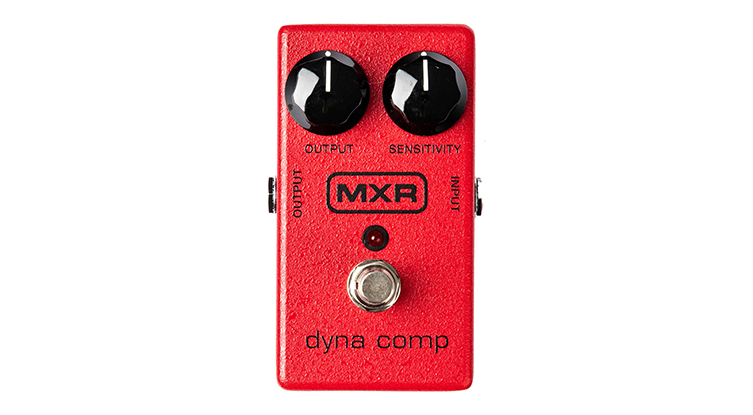
Compressor: Clean sounds can benefit from compression to smooth out inconsistent picking and introduce a layer of ‘production’ to your sound. Many compressors exist out there: the MXR Dynacomp is an enduring Nashville favourite. I’d also add the Keeley Compressor Plus as a personal all-time favourite.
Overdrive: put a little bit of hair on some lead parts with a transparent overdrive. Keep it simple and classic with either a Tubescreamer or any of the myriad Klon Centaur ‘Klones’ that exist: try an Electro-Harmonix Soul Food for a good example of that. My other overdrive choice would be the MXR Duke of Tone, a very useful take on the famous Analogman King of Tone. Why stay on a waiting list for 19 years just to get an overdrive pedal?
Reverb: If you don’t get reverb from your amp (or want to switch it on or off) then you’re spoiled for choice with reverb pedals. Spring reverb is what to look for, and I’ll cut to the chase and simply recommend the Strymon Flint v2. It’s a great sounding reverb, an amazing sounding tremolo, and you’ll love it. Actually, it’s pretty expensive, so here’s a cheaper reverb that is equally good for haunting country vibes: the BOSS RV-6 Reverb. In a crowded market, BOSS still deliver more, and better, than most.
Phaser: You might think that a phaser is a bit ‘psychedelic’ for country playing, but you actually hear it all over certain 70s country tunes. Waylon Jennings was a big fan for one thing, and there’s actually a signature Fender Waylon Jennings Phaser available! Otherwise, there’s very little out there to persuade me that the MXR Phase 90 isn’t still the ultimate phaser pedal. Just go easy with it, and don’t leave it on for entire songs or it’ll get old very quickly.
Guide to Cowboy Hats & Boots
Sorry, I can’t help you much here. Bring a friend when you go shopping for your cowboy clobber and don’t let anybody talk you into buying clothes you don’t feel comfortable in, ok? Ultimately, only you can decide how you really feel about ‘fringing’.
Country Guitar Tone
That’s the basics of country tone, as I see it. It’s not a complex equation: Telecaster, compressor, tube amp, dash of reverb peppered in. I won’t go into string gauge and picks with you because those decisions are a matter of personal taste and feel. Choose and use what you like, and change them up if you aren’t getting what you need. Heavy picks can make a big difference to your lead playing, but might also mess up your rhythmic vibe, and so forth.
Country guitar playing is kind of like rock-style shredding in a sense: it’s difficult and technical, but also very easy to overdo. Practise your bag of tricks for sure, but understand that country guitar playing is - like all other genres - mostly about the rhythm. There’s plenty of space for lead parts, but playing for the song (and the singer) will have you sounding like a pro more than either showing off too much or showcasing any particular gear choices.
That said, playing a country gig with an ESP and a 5150 is maybe not going to be a cool, bold thing to do. Stick to what I’ve mentioned to you today and you’ll be all set up to win.

